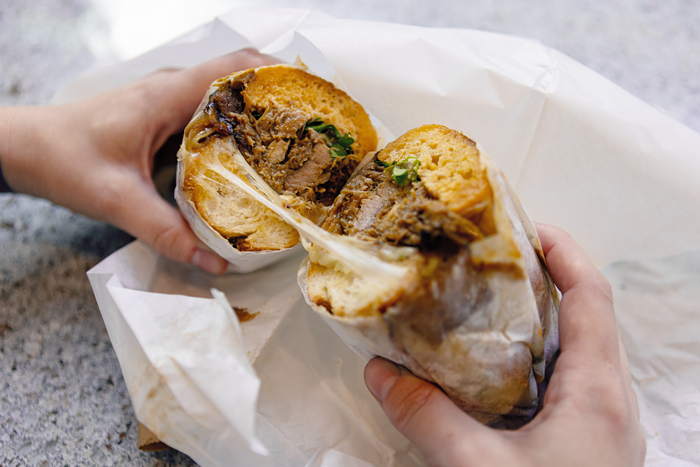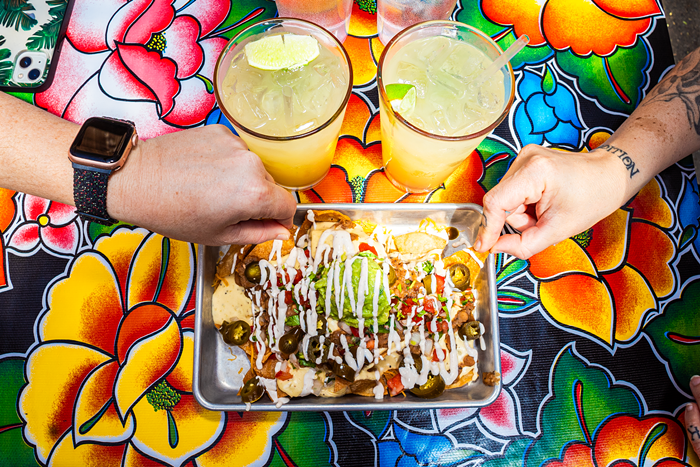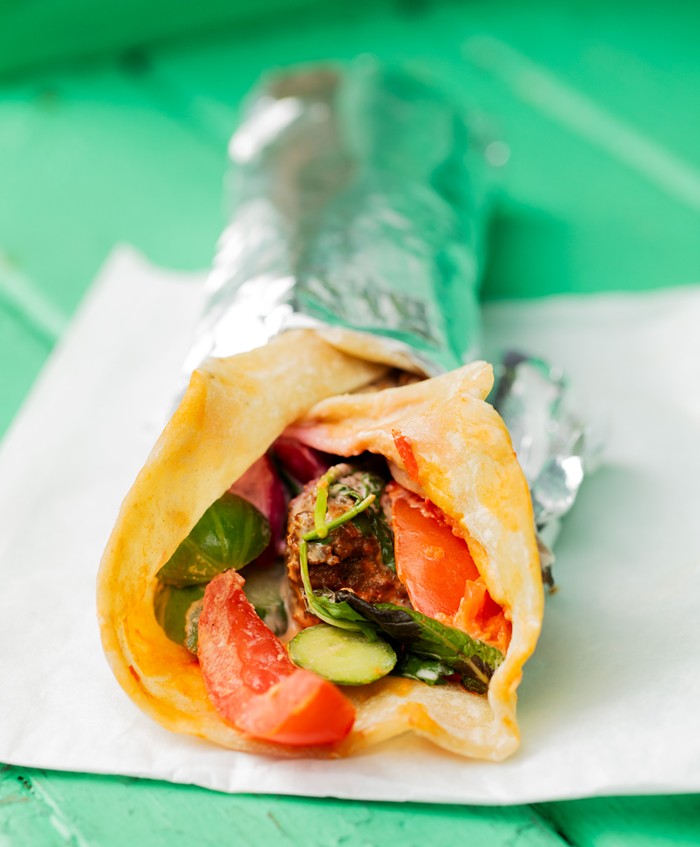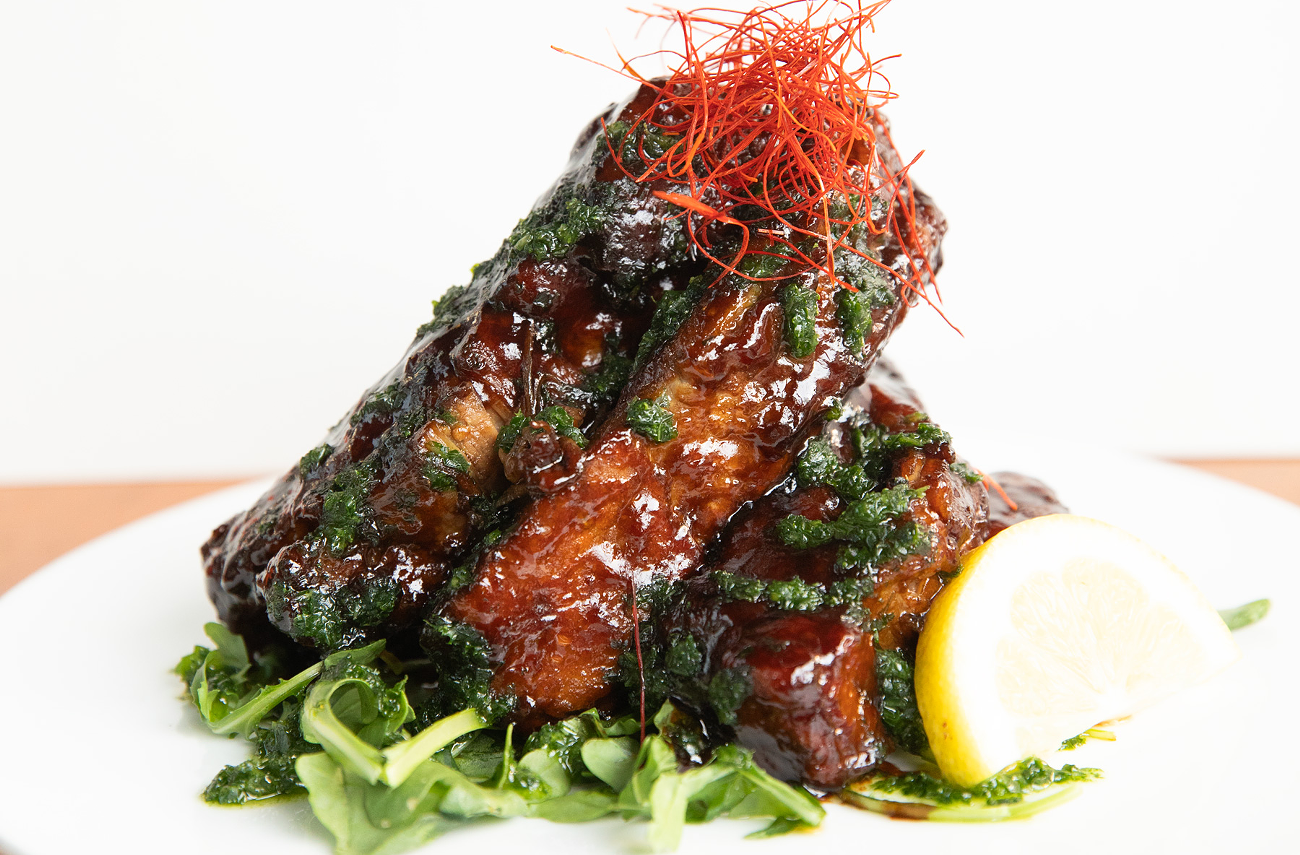Hey, so. As in many US cities, Seattle’s restaurants are in trouble right now. We food writers have lately found ourselves accidentally moonlighting as unlicensed therapists lately, logging countless hours hearing the very legitimate woes plaguing the restaurant industry. It’s rough out there. As I speak with our city’s restaurant owners and employees on the reg, I can’t help but feel all the sloppiest emotions about how they’re doing, if they’re experiencing a hiatus or an expansion, a chaos or a trauma, a joy or a triumph.
It’s bad on the journalism side too: We’ve got corporate influencers rating our hallowed dive bars on their brunchability and customers piling on angry Google reviews for months after a bad server has been let go. I’ve sat and cried along with more than one Seattle restaurant owner this year, and I bet I will again before New Year’s.
These sloppy feels of mine couldn’t help but shape this list. This Best Restos lineup is the most difficult and labor-intensive thing I write all year, because there are so many fucking great restaurants in Seattle. I could put a hundred of ’em on this roster, no sweat. My criteria here is scattered—it’s a mix of creativity, affordability, quality, boldness, and the owners being cool and not giant pieces of shit. I tend to be turned off by restaurants owned by corps and more attracted to scrappy, indie-owned projects. Authenticity has its place for sure, but I don’t value it as much as food that tastes good.
A few of these spots either are or started out as trucks and popups, and the former are usually left off other outlets’ best resto lists—an injustice, I say, as Seattle’s landlords continue to gouge tenants for sport and it becomes harder and harder to maintain a brick-and-mortar. And it’s not only about the great food here, although indeed it’s all great—I’m also recommending these restaurants for who runs them and what they stand for.
Ultimately, this is a year-long personal diary of the places where I had the most memorable meals that all gave me the best parties and sweetest emotions. I want to kiss all these restaurants on the mouth (consensually), and soon, I hope, you will too.
Rondo Japanese Kitchen
Capitol Hill

Back in the spring, when a friend suggested Rondo for his birthday dinner, I was like “Oh, hunh, I’ve never been—isn’t that place mobbed all the time?” Turns out, yes, and there’s a reason for that. Rondo’s
a platonically ideal example of why I stand on the soapbox of “just make a reservation” and yet… I didn’t take my own advice and robbed myself of years of immense pleasure.
Chef Makoto Kinoto is known for his playfulness, and straight away, the fun that was had in naming dishes like Mr. Pork Rib, The Hellz Chicken, Uni Jewelry Box, and Oh!! My Shu-mai is evident—and infectious. I still don’t know what the other B stands for in the Wagyu B.B. Bolognese, made with butter, parm, and oyster sauce (is it like “ATM machine”?), but I always enjoy coming up with new guesses when I order it. Another of your new faves is the curry donut, with Rondo’s famed 224 Curry over ramen with crispy Chinese donuts stabbed into it. It’s worth calling out the curry separately, since it’s a beef-and-pork variant of Tamari Bar’s all-beef Area 206 curry (also made by Kinoto) that’s been attracting long lines at T-Mobile Park.
Noodles, curried and otherwise, are a house specialty here, along with fried chicken and sushi, and you don’t want to skip the gorgeous rainbow chirashi bowls. Kinoto definitely has a thing for uni (sea urchin) in particular, and it pops up in the chirashi often, as well as the apps and the specials.
It’s easy to get distracted by the killer food at Rondo, but look around you: The restaurant rocks a subtle Dragonquest theme and is chock full of video-gamey works by local artists. Anime films are projected on the wall, there’s a Shinto shrine behind the bar, and action figures peer out of display cases. In fact, Rondo itself is a bit of an enchanted lair from a video game, where you abscond from the urban crush of Broadway and are teleported to a different world. From the buzzy city world to the cartoon food world.
Although Rondo’s menu is indelibly Japanese, it’s anything but traditional. With its wacky dining room and playful, singular dishes that Kinoto made up inside his brain and you won’t find anywhere else, a meal here is a guaranteed joy, no matter what you order.
Los Costeños
Chinatown–International District

It slightly enrages me to walk through the Uwajimaya food court and see that this little sandwich stand isn’t constantly mobbed, the way its cousins Un Bien and Paseo always are. Owner Francisco Mendoza worked at Un Bien before opening Los Costeños in late 2022, serving the selfsame iconic Caribbean pork shoulder sandwich, replete with the caramelized onion ribbons and everything. They’re cheaper and way meatier than their competitors, and you can get them with added Swiss cheese and/or ham for an extra dollar, which you should do. The hyper-flavorful pork is also available as a plate with corn, beans, and salad, or in nacho format.
The menu includes 10 or so other Mexican Caribbean sanduiches—my runner-up is the scallop sandwich that comprises seared scallops, olive oil, garlic, mayo, green olive tapenade, cilantro, jalapeños, and caramelized onions. You’d think a scallop sando might be tidier than the sauce-simmered pulled pork, but nope, it’s no less a voluptuous deluge of saucey sauce.
There are two rules to these sandwiches. One is that you must ask Francisco to cut it in half for you because these sandwiches are utterly packed with meat like it’s someone’s last day on the job, and the entire thing will fall apart and pour all over your clothes if you try to eat it whole. Once halved, unwrap it as you go. The other is that I’ve heard complaints from people who try to take one of these things to the sports games, and don’t do this, because you need a table to sit at and a plate to hunch over—see Rule #1. Have a seat and commit yourself to an immersive experience. Lose yourself to this sandwich. You have time.
Sophon
Greenwood

You know I had to do it to ‘em. As is well documented, I can’t holler enough good things about Sophon, and Seattle seems to agree—since their February soft opening, the restaurant’s been booked nearly solid. (Pro tip: You can usually finagle a seat at the bar as a walk-in.) Chef-owner Karuna Long’s unique Cambodian diaspora cuisine is like nothing you’ll find anywhere in Seattle. Even in cities like LA and Boston, with large Khmerican communities and a handful of restaurants representing the Cambodian diaspora, Sophon stands out, as the others are mostly fast-casual.
Never had food from the Cambodian diaspora? Here’s your first-time order. Start with the super-snackable Khmer-aage, a mix of Japanese-style fried karaage chicken and Cambodian kroeung curry, available with chicken or (vegan) mushrooms and served with spicy Southeast Asian “crack sauce” on the side. You want the piquant nhoam salad, made with citrus-cured prawns, English cukes, cold vermicelli, bell peps, Thai basil, mint, dried shrimp, toasted coconut and peanuts, and a fish-saucey tuk trey dressing (but can be made vegan). If you eat meat, the worldview-changing kha sach chrouk is your entree: a low-and-slow slab of pork belly that’s been caramelized in palm sugar and braised in coconut milk, star anise, and sweet onions, then served with julienned pickled daikon and a jammy boiled egg. Another unskippable side, the p’set ang, is a mess of grilled foraged trumpet mushrooms anointed with kroeung curry oil, spicy tomato relish, and microgreens. Add a side of rice to sop up all the flaves.
For dessert, it’s pastry chef Teresa Hong’s brilliant makrut lime tart, in the style of a key lime tart, poured into an almond crust and capped with Swiss meringue, macerated green mango, and Thai basil. I won’t guide you toward a specific cocktail, since beverage director Dakota Etley’s menu is an album of bangers, but the Khlang—with brie-washed rye, sweet vermouth, nocino, and delicata squash tincture—has recently returned to the menu after a summer vacation, so it’s a real good place to start.
No one else is doing anything like this. Yes, Seattle has a few Cambodian restaurants, but they’re pretty traditional (not that that’s bad! It’s good!), and Long’s creative experimentation is giving new life to a culture that was nearly wiped out within living memory, through its cuisine. Bon Appetit just lauded Sophon as one of the best new restaurants in the nation, which made me cry on the train, and that’s just the beginning. All eyes are about to be on Sophon, and if yours aren’t yet, you need to get ‘em on there.
Situ Tacos
Ballard

I don’t normally rave about a brand-new thing, much less put it on a best kinda anything list, until it’s had a sec to find its stride. But I’m making an exception for Situ Tacos, because damn, Chef (and badass rock drummer!) Lupe Flores and her team have really hit the ground running.
It’s no mystery why. After popping up around Ballard for a year or two, Flores’s sassy taco stand moved into Belltown’s Jupiter Bar in 2021, where it swiftly became a beloved neighborhood fixture. Flores, who was wearing a jumpsuit with knives printed all over it the first time I met her, makes tacos in the style of her Mexican-Lebanese grandmother—situ means “grandma” in Arabic—that’re stuffed with hushwe (ground beef cooked in browned butter), garlicky mashed potatoes, or harissa-ed cauliflower, then stitched together with toothpicks and deep-fried until crispy-golden. She’s also the queen of soup, cooking up a different flavor almost every day, and it’s never not incredible.
This stuff has been my late-night meal while carousing through the Belltown barscape more times than I can count. When Flores moved into the old Bitterroot BBQ space on Ballard Avenue, with an expanded menu and a sexy cocktail lounge in the back, I cheered right out loud.
If the food at Situ wasn’t fantastic enough (it is), the alpha-femme vibe would make me want to hang out here anyhow. There’s something Love and Rockets about the space, especially the snug back bar with the old warehouse grid windows—I can see Maggie and Hopey back there playing footsie over some Tecates as the sunlight filters over them.
Although bigger than before, Situ’s menu is still small but mighty. They’ve got the crunchy tacos dorados, chip-based things like nachos and chilaquiles, rolled taquitos in either carnitas or papas, some breakfast burritos and tacos with egg and potatoes added, and Flores’s rotating soups. The bar rolls the same way, with uncomplicated drinks like margs and agua frescas, available with or without booze. That’s it, because there’s no reason to mess with a good thing. Simple, delicious, unpretentious, and bold. Big crush.
Indian-Nepali Kitchen
Licton Springs
Rarely does a restaurant being attached to a seamy motel at 90th and Aurora inspire confidence. But whew, it really drives the plot in this case, because the food at Indian-Nepali Kitchen restaurant is so luxurious and show-stopping and goddang good. What a cinematic reveal. Out there on the highway, you just don’t see it coming.
Casual and understated at first glance, with maybe a dozen tables, this newish restaurant’s got a truly massive menu of Indian dishes and a smattering of Nepali ones, delivered in monster portions at affordable prices. The Indian classics, like lamb biryani and chicken jalfrezi, are rich renditions, and it’s hard to mess up on this part of the menu. But if you’re like me and have spent your whole life in Seattle, where there are legions of Indian restaurants and few Nepali ones, head straight to the last page.
Dazzle your dinner date with the opulent khaja set. It’s a platter heaped with chiura (flattened rice, which sorta looks like Idahoan mashed potato flakes), kidney beans, crispy soybeans, fried egg, papadum, fresh cucumber and carrot, and your choice of chicken or goat curry in a little brass bowl. As you spoon the curry over the chiura, it re-hydrates a little, while retaining its Rice Krispies-like texture.
The mixed chow mein was another dramatic surprise—this is deluxe Nepali-style chow mein, a hill of slick, yellow noodles fried with turmeric and ginger and garlic, along with a pinch of seemingly every kind of meat and vegetable they’ve got back there in the kitchen. There are so many different items in this chow mein that my party gave up trying to backtrace the ingredients and just dunked ourselves whole in the moment.
Other memorable bites include the vivid combo momos (meat-filled dumplings), which come in a melange of colors and flavors, as well as the fragrant sadheko chicken (sadheko means “marinated”) in a chunky, bright-orange sauce that’s spiced with jimmu, a Himalayan herb in the allium family. The lamb boti, too, is an expertly styled version of the classic. After five visits, I haven’t even put a dent in Indian-Nepali Kitchen’s colossal food manuscript, but I’m confident in saying it’s all bulletproof. I’m treating the menu as a personal to-do list.
Maybe you’re not looking for histrionics in your dinner, but the aesthetic chasm between the restaurant’s location and the astronomical quality of the food inside kinda can’t be ignored. A restaurant of this quality in a Gucci-er neighborhood would hit different. It’s not just an amazing meal; it’s the feel-good dinner of the year.
Vindicktive Wings
Belltown

So, I don’t really enjoy wings as a category, and it’s 100% Seattle’s fault. We suck at wings here, because we think of them as snacks, in league with waffle fries and jalapeno poppers. We don’t respect them. Go to your neighborhood sports bar and get some wings, and nine times out of 10, they’re undercooked and you have to fight with the meat to get it off the bone. To me, there’s not much grosser than the mouthfeel of flabby, rubbery unrendered chicken skin where it feels like you’re eating a nose.
That’s the gold standard in the Northwest! It’s gnar, and I’ve always steered clear.
Well, guess what, now I love them! And it’s 100% Vindicktive Wings’s fault.
At this Belltown pub, the wings are small and light, crisp but not crusty, and the barely-battered chicken skin shatters like the exoskeleton of a banh mi. They’re flavorful, juicy, and easy to tear into. The lemon pepper stands out for being extra-extra black-peppery, and the lemon flavor’s not fake. It is made from a lemon. They’re drenched in real butter but it gets absorbed a little, so the surface of the wing is not saturated, just shiny. Not sure how the kitchen is achieving all this alchemy, but it’s something that few local spots know how to do at all, to say nothing of doing it this well. I’m always in search of a simple dish done correctly, and these wings are an astounding example.
Vindicktive is owned by two sets of brothers—twins Vin and Dominick Minchiello, hailing from Buffalo, and non-twins Mike and Fletch Morgan from Spokane. Along with the scientifically correct wings, the Buffalo Brothers are also offering a few New York State delicacies: The garbage plate, made with mac salad, ground beef, onion, and tater tots, started out as a special and then people went so ballistic for it that it’s been added as a regular menu character; and they debuted a luscious chopped cheese soon after. You can also get Genesee Cream Ales, in the giant cans, and on the weekends, they’re doing the NYC-style bacon, egg, and cheese bagel.
It should be mentioned that the Vindicktive crew has some, ahem, trenchant views on what makes a wing correct—and what’s acceptable to dip it in. Someone on IG recently spotted a bottle of ranch on the sidewalk outside the shop, ostensibly brought in by a patron because the restaurant refuses to serve it, offering only blue cheese dressing instead. They’re also hellbent on using a specific, smallish style of wing and frying them hard, seasoned only with salt and pepper, and letting your sauce of choice do the work.
What the hell ever. When you serve wings flawless as Vindicktive’s, you make the rules, and it’s our privilege to abide by them.
Yalla
Capitol Hill

Chef Taylor Cheney would be Seattle’s MVP chef of the year even if she owned an Arby’s, thanks to her tireless work promoting Palestinian cuisine and culture and raising crucially needed funds for the Palestine Children’s Relief Fund. Although Yalla’s fundraised for the PCRF since the restaurant opened in 2019, Cheney sprang into double-time action just weeks after Israel began bombing Palestinian civilians last October, hosting a series of popups that raised tens of thousands for starving, wounded, and homeless kids on the other side of the world. The woman’s a fricking saint who’s donated tremendous portions of her own income to help Gazan babies, using her white privilege to boost the signal.
It’s a divine double happiness that Cheney’s food is also incredible. On the cruisiest stretch of Olive Way, Yalla is a tiny postage stamp of a kitchen that’s churning out huge, intense flavors via saj, an unleavened flatbread commonly eaten in countries like Lebanon, Syria, Jordan, and Egypt. Using saj as an artistic conceit, Yalla serves it dressed with falafel, fried eggplant, lamb, soujouk (sausage), grilled halloumi, labneh, or just a dusting of za’atar.
All the meat served here is halal, and there’s a whole veggie menu with several vegan picks, like the fityr: grilled mushrooms and green peppers, garlic, tomatoes, green olives, cucumbers, greens, and mint, all wrapped up in saj. Yalla’s open during the day, but it’s kinda more fun to eat it in the wee hours, when you’re bar-hopping on the Hill. Even if you don’t drink, heading to here at a more mature hour lends itself to the experience: ordering from a little window on a busy street in the night.
My go-tos at Yalla are the lahme khuruf with labneh: ground lamb sauced with pomegranate molasses and mixed with toasted pine nuts, tomato, mint, and the house-strained labneh. The mint and the lamb fat and the sweet pom molasses and the yogurty labneh all commingle together and do something important as a team. Just like coming together as a group to organize and protest war and injustice, hey. Seattle’s impossibly lucky to have precious Yalla, and especially a chef-owner—and comrade—like Cheney.
Mendoza’s Mexican Mercado
Green Lake

As last year, I’ll still fight with anyone who says Seattle doesn’t have any good Mexican food. This was true decades ago, because we didn’t have very many Mexican or Mexican-American people living here then. But in the last four years, the Mexican population in Seattle has tripled. It’s still not California or Texas, but look around you in Northgate and Beacon Hill and South Park and Ballard and Georgetown, and then stop saying this outdated, foolish thing.
Speaking of decades. About 10 years ago, I used to go to Mendoza’s regularly for taco times, thrilled to find cabeza or nopales or goat birria or beef shank guisado tacos waiting next to the giant cow skull in the hot case. Then we moved to another neighborhood and forgot all about this place. An egregious life mistake. Well, a friend re-hepped me to Mendoza’s a few months back, and it was a total bolt from the blue, to return to this sweet Highway 99 bodega and see the cheery Talavera tiles and papel picado garlands again. Why haven’t we all been hanging out here constantly? Moving away is not a good enough reason—these tacos and tamales were always worth traveling across town for.
It’s still true. Our re-inaugural meal at Mendoza’s was a panoply of tacos—guisado, carnitas, goat birria, cabeza (they still display the skull in the case!), and slow-cooked lamb with maguey (agave)—and we snagged the last two tamales, one carnitas and one cheese-and-jalapeno. It took us about four American minutes to hoover up this gorgeous spread. Best flaves were the extra-porky tamal, the goat, and the velvety cabeza, but they were all baller.
Then I went back the very next day with my partner, and we feasted on a whole different spread: guisado de res, carne asada, and nopales. He pointed out that the refritos are hands-down his favorite in Seattle, a fact that’d been lost to time as well. I got a bag of tamales to go and lived on them for two days, and my boyf bought some fresh salsa rojo and a bag of chapulines for the road. Now we go there all the time again, very merrily, and our error is mended.
One still must compensate for a lost decade of taco eating, so I have a lot of work to do at Mendoza’s. Considering the current restaurant climate in Seattle, we’re fortunate it’s still there and we’re able to catch up. Thankful for Mendoza’s presence in my life. I’m glad we still ride together.
Slice Box
SoDo and Magnolia
Pizzas are like dogs; there’s a billion different styles and sizes and genres, and some of them don’t even genetically resemble each other but are somehow still all called pizza. It feels like Seattle is a microcosm of the all-encompassing pizza world lately—we suddenly have like 50 new kinds of pizza available to us, of every stripe, all happening at once.
To this end, I ate a lot of fuckin’ pizza this year, both delicious and not, in a quest for the best. I watched the Kenji videos and read the Seattle Times pizza-weighing faceoffs. I tried the pizza that you have to wait three months to eat (well, not anymore) and sampled a whole globe’s worth of Detroit slices and Chicago slices and Sicilian slices and Tacoma slices and ripped them all open to inspect their architecture, trying to feel some kind of pizza emotion. I guess I wanted to be wild for pizza, like the molecularly gastronomical pizza dorks on Instagram. I wanted to fall in pizza love.
It took way too long, but all of this research eventually brought me to Slice Box in SoDo. They do foldable New York-style slices that made me say “yes” out loud when I picked one up, and I immediately knew why. Slice Box’s pep slice looks and tastes like clipart of a pepperoni pizza, and damn if that’s isn’t what I want most of the time. The pepperoni is cuppy but not obnoxiously so, with shallow pools of pepperoni oil collected in each one and a barely singed rim, giving the meat some texture but not drying it out. The bottom’s crispy but not tough. The sauce is loaded up with hella basil and made from ripe garden tomatoes, which scans, since owners Ryan and Leanna Lengle are gardeners, and the pie is neither skimped by it or drowned in it. Christ, that pepperoni slice is really something. The very thought of it is like the sun in Super Mario Bros. 3—it keeps following you after you leave.
Also, it passes the most important pizza test of all, which is: Do you want to eat the pizza bones? At Slice Box, I would fight you for them.
People who make classic pepperoni pizza well don’t always get their flowers, and I would like to take all the flowers from other pizzerias and award them, at least just for today, to Slice Box for doing the thing simply, with high production value and quality. They’re providing an invaluable service to Seattle out there, making ‘80s roller rink pizza except good, for the simple folks like us. I mean me.
Homer
Beacon Hill

Remembering a meal at Homer is more of a sentimental warmth than a keen recollection. The menu is built around shareable Mediterranean mezzes that change all the time and become a big blur of roasted cauliflower and pistachio dip and olive-oiled chickpeas and goat cheese and pickled beets and sardines. You bring four or five of your friends and order all these little dishes, and they bring you a steady stream of slightly charred bread straight out of the wood-fired oven, and you and your pals just go to town. Everyone is swiping their bread triangles into everything, and it all blends into a blurry, soft, candlelit AI memory.
I do remember the dish at Homer that first made me feel this way, and that’s the lamb ragu in tahini. This one’s always on the menu, and it’s a puddle of tahini blessed with yogurt, fresh dill and parsley, harissa, and juicy chunks of roasted lamb. It is flawless in its construction. On the first bite, I felt a tempest blow through my heart. If your whole lifetime were compressed into an evening at Homer, this dish would be the love of your life.
That one and the grilled sourdough with whipped garlic are the first things to order on every visit. Better known around the world as toum, it’s just a cloud of garlic, olive oil, salt, and lemon, with a big crevasse whacked into it and filled with more olive oil. The bread, too, is incomprehensibly ever better than the charred pita you’ve been eating all night.
At the end of the meal, they have soft-serve, in curious flavors like vanilla–marigold and pistachio–orange blossom. Sort of surprising to see a big AM/PM soft-serve machine behind the bar at a place like Homer, but it’s always so charming to finish your meal this way, and especially to order a swirl, served in a frosty tin cup.
Once you’re done, for the next few days, garlic will seep out of your pores, as a peremptory reminder of the extraordinary life you have been living. What specific dish did you even have that had so much garlic in it? And wait, what was the genius line your friend said that cracked the whole table up? What was that one bite that made you swoon so deliriously? Oh yeah, it was everything.
Gold Coast Ghal Kitchen
First Hill

In late 2023, as Chef Tina Fahnbulleh was putting the finishing touches on Gold Coast Ghal Kitchen, the foodie folks were beside themselves with excitement. That’s because Seattle’s had a real dearth of West African cuisine, particularly Ghanaian and Liberian, and also because we already knew about Fahnbulleh’s mighty culinary prowess (she’d been popping up around town for years). Oh man, I was counting down the seconds.
Fahnbulleh built out the space herself, and it’s just stunning, with Twi-language word art, white stucco walls, earthy sculptures and beadwork, and cool-clean vibes. Despite its elegant interior, Gold Coast Ghal Kitchen’s menu cheerfully encourages guests to eat with their hands, pointing out that fufu in particular is an interactive food that should be used to sop up all the delicious broth or stew.
Your first stop on the GCGK menu tour should be the goat groundnut (peanut) soup: a glossy, peanutty broth spiked with tomatoes and okra, with a huge, meaty goat neck bone plopped in the middle. Grab it with your hands and gnaw on it like a turkey leg, and then soak up the rich soup with the fluffy fufu cloud, which you’ll add as a side. (There’s a vegetarian option with mushrooms, for those so inclined.)
The beef empanadas are tied with the groundnut soup for my favorite app at GCGK—the ground meat’s full of ginger and cayenne and curry and bell peppers, and the buttery crust is balanced out precisely by the side of cilantro aioli. These hand pies make me want to compile a list of the city’s best empanadas just so I can give them the gold.
For entrees, one absolutely must not skip the succulent branzino platter. The dish is a sight to behold, firstly, with brilliant roasted veggies surrounding a broiled whole fish on a bed of attiéké (grated cassava). This dish packs enormous flavor, thanks in part to the Liberian hot sauce, made with green chiles and garlic. Everyone’s doing a branzino dish lately, and I tend to think of branzino as a bland nothingfish, but this dish totally cured me of branzino fatigue.
Another unforgettable GCGK entree is waakyé, a hodgepodge of spaghetti, beef stew, black-eyed peas, rice, fried plantains, cabbage slaw, gari, soft-boiled egg, shrimp-based pepper sauce, and grilled head-on prawns. It’s like a plate at a potluck, and each element complements and enhances the others.
Gold Coast Ghal Kitchen deserves accolades for its beautiful bar too, and especially for the cool stuff they’re doing with unusual cocktail elements like palm wine, tiger nuts, and grains of selim: seeds of the tropical xylopia aethiopica tree that taste like nutmeg and peppercorn. I learn so much about botany with every visit.
Lenox Afro Latin Soul
Belltown

I knew Lenox was going on this list on my first visit, after the very first bite of the very first starter.
Chef Jhonny Reyes is another glimmering success story in the pantheon of Seattle chefs who’ve lately transitioned from truck to brick-and-mortar. Raised in South Seattle but born in Spanish Harlem, Reyes had set out to echo his tio’s and abuela’s food, through dishes like ropa vieja and picadillo, filtering in elements from his Puerto Rican, Cuban, and Jamaican heritage. In June, after a long hiatus from foodtrucking, Reyes at last opened the newest incarnation of Lenox in the old Jerk Shack space, a tropical butterfly from a chrysalis.
Named for Lenox Avenue in Harlem, aka Malcolm X Boulevard, this long-awaited restaurant is an absolute vision. Stepping inside Lenox is a trip, and I mean that in both ways—it’s, y’know, a trip to the Caribbean and everything, and it’s also a fuckin’ trip to see how they’ve transformed this well-known space. The aesthetic is very Old Cuba: fresh roses on the bar, rattan lampshades, lush potted palms waving you on in.
Reyes has stepped up Lenox’s menu while retaining a selection of old Nuyorican cornerstones from the truck era—like the gorgeous, life-altering Tres Hermanas with housemade green goddess dressing, the first bite of which sent me into orbit, as above. The Tres Hermanas are Latin America’s agricultural three sisters—yellow squash, corn, and (in this case, green) beans—to which Reyes adds pickled cherry tomatoes and farmer’s cheese, then makes it the shoreline of a light-green lake of green goddess. I can only guess what’s in the dressing—garlic, cilantro, parsley, mint, lemon, yogurt? Tahini? He’s gotta put something else in there. It’s like if salad were ice cream.
The Tres Hermanas had already sealed the best resto deal, but the lechon was easily the most transformative dish of my year. It’s described so maddeningly simply on the menu too—”crispy-skin pork belly, arroz gandules (rice with pigeon peas), coco greens, and pickled mustard seed”—although the fact is that no amount of human words can do this dish justice anyhow.
The rich, crackled-out pork, and the pickled onions on top of it, and the complicated spices and texture in the rice and beans, and the moat of currylike sauce that surrounds it all… I didn’t know what to do. I was like James Joyce’s Molly Bloom, stepping out of the black-and-white pages of Ulysses, from the flatness and into the sensual real world, after that first bite.
And that’s all before we’ve gotten to the smooooooth coco greens on the side, with bird’s eye chili and Sazon and whatever Reyes does to the potlikker. I wanted to take a nap in these greens. And the green goddess dressing too. And the mojito, and the rockfish ceviche, and the caramelized onion soubise on the bistec encebollado...
Suffice it to say that it’s all exquisite, and if you haven’t been to Lenox yet, you’re late. Reyes’s beautiful dream has come together like a perfect symphony, and I’m throwing my ass in a circle to this song.
Kilig
Chinatown–International District
Like you, I’m pumped that Musang is back open after a flood knocked them out of biz for months, and I’m rejoicing right along with them. But I confess, my very favorite project of food genius Melissa Miranda’s is Kilig. It’s bright, it’s punchy, it’s simple, it’s fun, it’s affordable, and every single item on the menu is a knockout.
During the rain season, I fantasize about Kilig all workday long, imagining braving the cold wet for a steaming bowl of bulalo to fog up the windows, and how totally worth it that would be. Although bulalo—beef shank stew with corn and charred cabbage—is the diva here, the kare kare dan dan also has my whole heart. Made with wheat noodles laden with short rib, tahini AND peanut sauce, okra, eggplant, long beans, and bagoong garlic chili sauce, this Filipino/Chinese mashup is total I-love-myself food. Opulent. What queens eat.
I’m also thrilled by Kilig’s beverage list, which factors in ingredients like calamansi, pinakurat (spiced coconut vinegar), and rum from Kasama, a woman-owned small-batch rum distillery from the Philippines. My go-to on Kilig’s drink list right now is the Kimlet, with Empress gin, Aperol, Cynar, and calamansi. The nonalcoholic tamarind ginger beer, with a sprinkle of sour sumac, is another star.
The restaurant’s name, by the way, is pronounced “kill league,” and it’s the Tagalog word for butterflies in your stomach. I don’t speak Tagalog, but I like to know how to say things correctly, so the mnemonic device I use is that Kilig’s in the league of Seattle restaurants that are fuckin’ killers. The Kill League. Because they’re killing it.
Le Coin
Fremont
Before I begin: Yes, I’ve seen the TikTok video, and yes, I’ve spoken to Le Coin’s owners about it. The server’s behavior was racist and unforgivable, and the owners were mortified. The owners say she was fired, a profuse apology was issued, and the woman who made the TikTok has expressed a desire to move on. So we will.
I kept ending up at Le Coin by accident all year. For drinks following a cookbook reading at the nearby Book Larder, to celebrate a family milestone, to kill time with a Garden Gimlet before karaoke around the corner at George and Dragon, to toast a friend who’d closed on their first home. For a quick dozen oysters to tide me and my partner over before a late dinner somewhere else. Again and again, Le Coin would quietly suggest itself, and we‘d all be so glad.
Everything on this menu makes me want to burst into tears. No exaggeration—the fennel confit with curried squash and roasted radishes wells me up, and that’s before we get to the cured lemon cavatelli with roasted garlic, beets, and chicory. Obviously, the steaks and lamb dishes all have this effect, with a zero process-error rate. Even the burger, served on brioche with caramelized onions and mimolette fondue, is goated beyond belief. I almost never fuck with a burger at a fine-diner, because I can make a fantastic burger at home, but… you and I can’t make anything like this at home.
Even spending happy hour at Le Coin is tantamount to an ayurvedic healing sesh. Perch yourself at the bar and order a Chartreuse slushie, as clean as a fresh sunrise, along with a plate of crispy butter-roasted Brussels sprouts baptized with fried garlic, a shucked dozen on ice, and a pork short rib with braised cabbage to make your heart glow in the way. Then lean back a little and bask in how beautiful your life is.
In comparison to most of this list, Le Coin’s a little tonier, a little more fance. But it still sticks to the original concept in its name—“the corner” in French—as a neighborhood spot. (And the staff doesn’t flinch at its name being pronounced in English.) I sincerely love being in this space and seeing the pinecone syrup steeping in the big jars and all the little tinctures and pickles that bar manager Matt Pachmayr has brewing back there. It’s the details as much as the features. The soy-pickled shiitake on the Momofuku Martini. The bone marrow aioli served alongside the frites. The unusual flowers on the tables: lantana, zinnia, Sweet William, Caspian sage. I love you, Le Coin, and I see you.
Buckshot Honey
Snoqualmie
About 45 minutes east, the mountain townlet of Snoqualmie probably doesn’t think of itself as being in the Seattle area, but I hereby decree it. Mostly so I can include Buckshot Honey on this list, because I can’t stop thinking about it.
Buckshot’s chef-owner Dave Van Storm earned his stripes in Seattle kitchens, and you may know him from the Odin Star truck that lurked around Ballard and LQA years back. But since 2020, he’s gone whole hog, setting up shop inside a historic bank next to Mt. Si and serving what he’s termed “Cascadian barbecue.”
This guy is doing fascinating and indulgent things with meat out in the mountains, especially brisket. This is terrific Texas-esque smoked brisket that falls apart when you breathe on it, and it’s available in all the menu stylings as well as by the pound. Most of Buckshot’s dishes are gently informed by other cuisines, like the sequoia pulled pork sando tossed in Argentine chimichurri and served on Jewish challah with the house’s signature black pepper mayo. Meanwhile, the Katz’s-ian Dave’s Way is a sandwich for a storybook giant, with a half-pound stack of heartbreakingly juicy brisket on light rye with roasted onions, pickled peppers, black pepper mayo, and provolone wiz. It’s a burly behemoth that I’m still fixated on, weeks later. This sandwich lives in my skull now. No brains, just a big sandwich.
The adobo pork shank for two is similarly bonkers in its sumptuousness: You get an entire bone-in shank that’s been smoked and braised in red Filipino adobo, topped with housemade chili crisp, and accompanied by papaya slaw and saffron dirty rice. I’m also impressed with Buckshot’s meaty take on an old-fashioned, using brisket-fat–washed bourbon and garnishing it with a smoked mini meatslab. Hedonism reigns at this place, and I’m here for it.
In addition to the based barbecue, it’s appreciated that Van Storm displays a real generosity of spirit and will befriend the shit out of pretty much anyone who stops by. He also does a yearly summertime pig roast for the community with a knife-sharpening contest, among other fun ‘n’ games, which is an even more excellent reason to drive yourself out to East King County.
I am sometimes crazed by thoughts of Buckshot Honey during the week, calculating when I can find time to zip up there, texting friends about whether they have time to come with. It’s just smoked meat, you say? You don’t have to go to Snoqualmie for that? It’s true that there are now a slew of hardcore meat palaces dotting Seattle, and many of them are great. But thanks to Buckshot’s cool innovation, down-to-earth style, and global culinary influences not often seen in the American barbecue sphere, this one’s definitely road-tripping for.
Still hungry? Read last year's list, The 15 Best Restaurants in the Seattle Area 2023, here for even more recommendations.




















